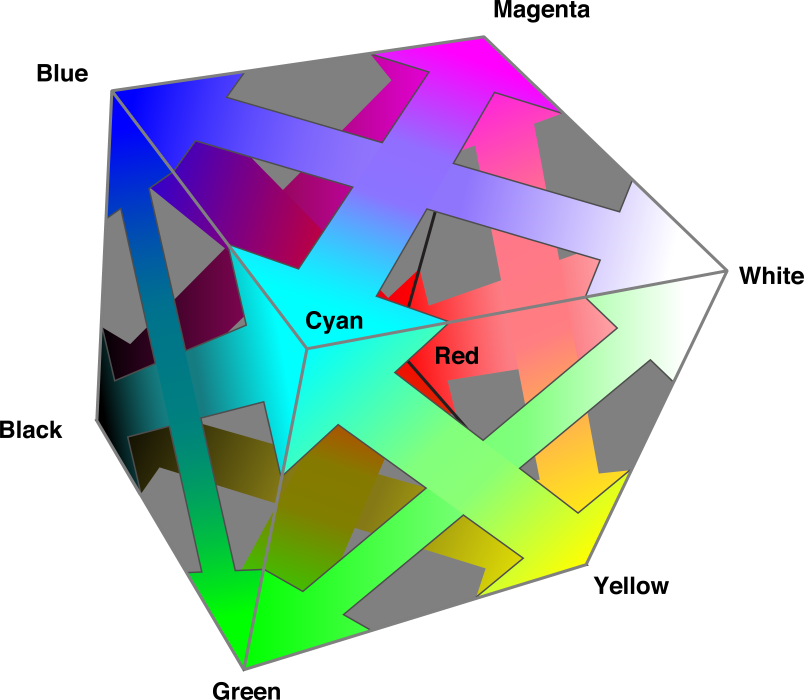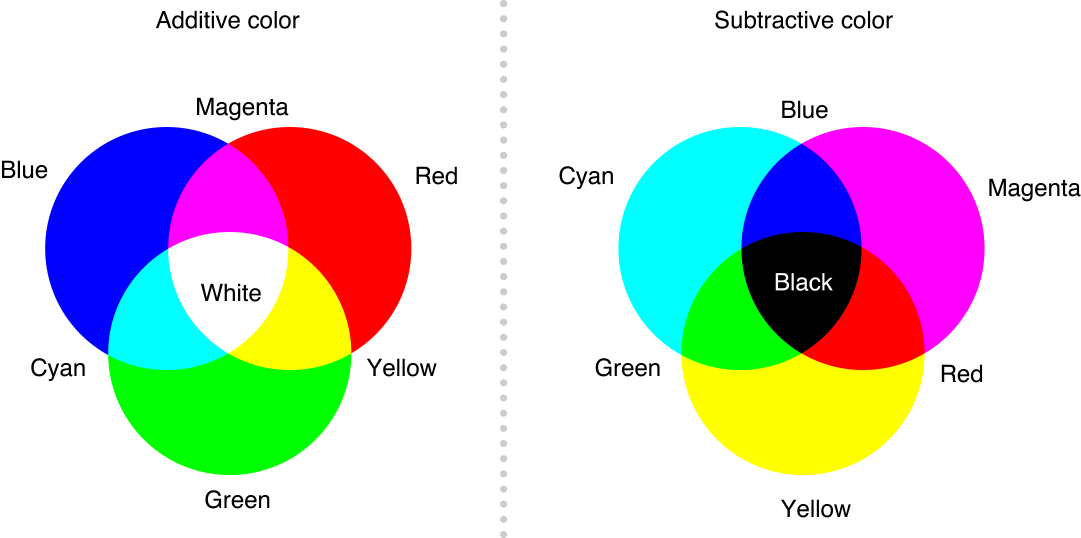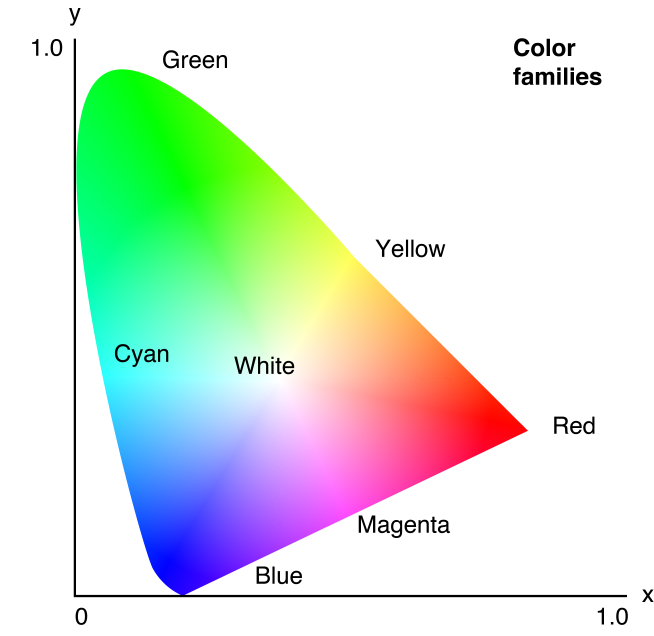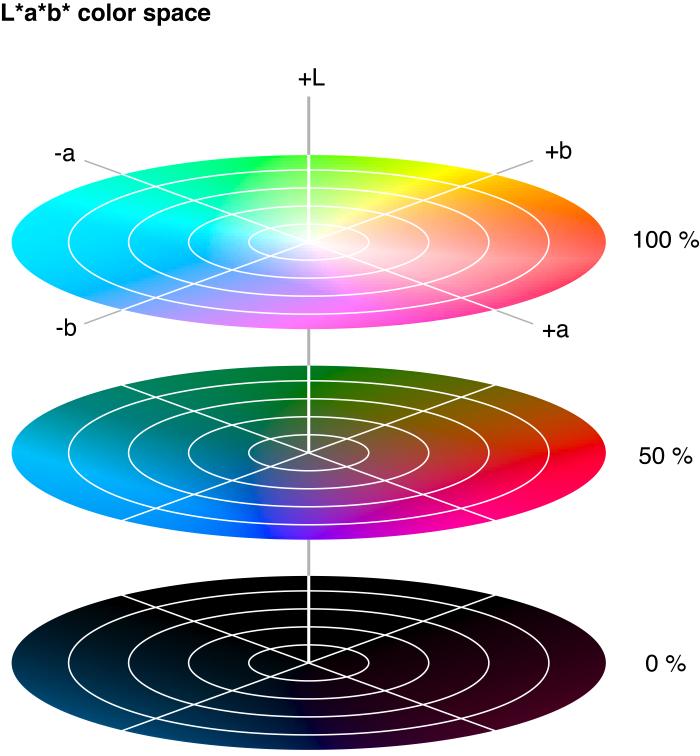Color Spaces
A color space describes an environment in which colors are represented, ordered, compared, or computed. A color space defines a one-, two-, three-, or four-dimensional environment whose components (or color components) represent intensity values. A color component is also referred to as a color channel. For example, RGB space is a three-dimensional color space whose stimuli are the red, green, and blue intensities that make up a given color; and red, green, and blue are color channels. Visually, these spaces are often represented by various solid shapes, such as cubes, cones, or polyhedra.
For additional information on color components, see Color-Component Values, Color Values, and Color.
Apple’s ColorSync technology directly supports several different color spaces to give you the convenience of working in whatever kind of color data most suits your needs. The ColorSync color spaces fall into several groups, or base families. They are:
Gray spaces, used for grayscale display and printing; see Gray Spaces
RGB-based color spaces, used mainly for displays and scanners; see RGB-Based Color Spaces
CMYK-based color spaces, used mainly for color printing; see CMY-Based Color Spaces
Device-independent color spaces, such as L*a*b, used mainly for color comparisons, color differences, and color conversion; see Device-Independent Color Spaces
Named color spaces, used mainly for printing and graphic design; see Named Color Spaces
Heterogeneous HiFi color spaces, also referred to as multichannel color spaces, primarily used in new printing processes involving the use of red-orange, green and blue, and also for spot coloring, such as gold and silver metallics; see Color-Component Values, Color Values, and Color
All color spaces within a base family are related to each other by very simple mathematical formulas or differ only in details of storage format.
Gray Spaces
Gray spaces typically have a single component, ranging from black to white, as shown in Figure 2-1. Gray spaces are used for black-and-white and grayscale display and printing. A properly plotted gray space should have a fifty percent value as its midpoint.

RGB-Based Color Spaces
The RGB space is a three-dimensional color space whose components are the red, green, and blue intensities that make up a given color. For example, scanners read the amounts of red, green, and blue light that are reflected from or transmitted through an image and then convert those amounts into digital values. Information displayed on a color monitor begins with digital values that are converted to analog or digital signals for display on the monitor. The signals are transmitted to the elements on the face of the monitor, causing them to glow at various intensities of red, green, and blue (the combination of which makes up the required hue, saturation, and brightness of the desired colors).
RGB-based color spaces are the most commonly used color spaces in computer graphics, primarily because they are directly supported by most color displays and scanners. RGB color spaces are device dependent and additive. The groups of color spaces within the RGB base family include
RGB spaces
HSV and HLS spaces
RGB Spaces
Any color expressed in RGB space is some mixture of three primary colors: red, green, and blue. Most RGB-based color spaces can be visualized as a cube, as in Figure 2-2, with corners of black, the three primaries (red, green, and blue), the three secondaries (cyan, magenta, and yellow), and white.

sRGB Color Space
The sRGB color space is based on the ITU-R BT.709 standard. It specifies a gamma of 2.2 and a white point of 6500 degrees K. You can read more about sRGB space at the International Color Consortium site at http://www.color.org/. This space gives a complementary solution to the current strategies of color management systems, by offering an alternate, device-independent color definition that is easier to handle for device manufacturers and the consumer market. sRGB color space can be used if no other RGB profile is specified or available. ColorSync provides full support for sRGB, including an sRGB profile.
Note that as an open architecture, ColorSync is not tied to the use of the sRGB color space and can support any RGB space that the user might prefer. For example, high end users with good quality reproduction devices may find that the sRGB space, which limits colors to the sRGB gamut, is too restrictive for their required color quality.
HSV and HLS Color Spaces
HSV space and HLS space are transformations of RGB space that can describe colors in terms more natural to an artist. The name HSV stands for hue, saturation, and value. (HSB space, or hue, saturation, and brightness, is synonymous with HSV space.) HLS stands for hue, lightness, and saturation. The two spaces can be thought of as being single and double cones, as shown in Figure 2-3.
The components in HLS space are analogous, but not completely identical, to the components in HSV space:
The hue component in both color spaces is an angular measurement, analogous to position around a color wheel. A hue value of 0 indicates the color red; the color green is at a value corresponding to 120, and the color blue is at a value corresponding to 240. Horizontal planes through the cones in Figure 2-3 are hexagons; the primaries and secondaries (red, yellow, green, cyan, blue, and magenta) occur at the vertices of the hexagons.
The saturation component in both color spaces describes color intensity. A saturation value of 0 (in the middle of a hexagon) means that the color is “colorless” (gray); a saturation value at the maximum (at the outer edge of a hexagon) means that the color is at maximum “colorfulness” for that hue angle and brightness.

The value component in HSV describes the brightness. In both color spaces, a value of 0 represents the absence of light, or black. In HSV space, a maximum value means that the color is at its brightest. In HLS space, a maximum value for lightness means that the color is white, regardless of the current values of the hue and saturation components.
CMY-Based Color Spaces
CMY-based color spaces are most commonly used in color printing systems. They are device dependent and subtractive in nature. The groups of color spaces within the CMY family include
CMY, which is not very common except on low-end color printers
CMYK, which models the way inks or dyes are applied to paper in printing
The name CMYK refers to cyan, magenta, yellow, and key (represented by black). Cyan, magenta, and yellow are the three primary colors in this color space, and red, green, and blue are the three secondaries. Theoretically black is not needed. However, when full-saturation cyan, magenta, and yellow inks are mixed equally on paper, the result is usually a dark brown, rather than black. Therefore, black ink is overprinted in darker areas to expand the dynamic range and give a better appearance. Printing with black ink makes it possible to use less cyan, magenta, and yellow ink. This may prevent saturation, especially on materials such as plain paper which cannot accept too much ink. Using black can also reduce the cost per page because cyan, magenta, and yellow inks are generally more expensive than black ink. It can also provide a sharper image, because a single dot of black ink is used in place of three dots of other inks.
Figure 2-4 shows how additive and subtractive colors mix to form other colors.

Theoretically, the relation between RGB values and CMY values in CMYK space is quite simple:
Cyan = 1.0 – red |
Magenta = 1.0 – green |
Yellow = 1.0 – blue |
(where red, green, and blue intensities are expressed as fractional values varying from 0 to 1). In reality, the process of deriving the cyan, magenta, yellow, and black values from a color expressed in RGB space is complex, involving device-specific, ink-specific, and even paper-specific calculations of the amount of black to add in dark areas (black generation) and the amount of other ink to remove (undercolor removal) where black is to be printed. Therefore, when ColorSync converts between CMYK and RGB color spaces, it uses an elaborate system of multi-dimensional lookup tables, which ColorSync knows how to interpret. This information is stored in profiles, see Color Management Systems.
Device-Independent Color Spaces
Some color spaces can express color in a device-independent way. Whereas RGB colors vary with display and scanner characteristics, and CMYK colors vary with printer, ink, and paper characteristics, device-independent colors are not dependent on any particular device and are meant to be true representations of colors as perceived by the human eye. These color representations, called device-independent color spaces, result from work carried out by the Commission Internationale d’Eclairage (CIE) and for that reason are also called CIE-based color spaces.
The most common method of identifying color within a color space is a three-dimensional geometry. The three color attributes, hue, saturation, and brightness, are measured, assigned numeric values, and plotted within the color space.
Conversion from an RGB color space to a CMYK color space involves a number of variables. The type of printer or printing press, the paper stock, and the inks used all influence the balance between cyan, magenta, yellow, and black. In addition, different devices have different gamuts, or ranges of colors that they can produce. Because the colors produced by RGB and CMYK specifications are specific to a device, they’re called device-dependent color spaces. Device color spaces enable the specification of color values that are directly related to their representation on a particular device.
Device-independent color spaces can be used as interchange color spaces to convert color data from the native color space of one device to the native color space of another device.
The CIE created a set of color spaces that specify color in terms of human perception. It then developed algorithms to derive three imaginary primary constituents of color—X, Y, and Z—that can be combined at different levels to produce all the color the human eye can perceive. The resulting color model, CIEXYZ, and other CIE color models form the basis for all color management systems. Although the RGB and CMYK values differ from device to device, human perception of color remains consistent across devices. Colors can be specified in the CIE-based color spaces in a way that is independent of the characteristics of any particular display or reproduction device. The goal of this standard is for a given CIE-based color specification to produce consistent results on different devices, up to the limitations of each device.
XYZ Space
There are several CIE-based color spaces, but all are derived from the fundamental XYZ space. The XYZ space allows colors to be expressed as a mixture of the three tristimulus values X, Y, and Z. The term tristimulus comes from the fact that color perception results from the retina of the eye responding to three types of stimuli. After experimentation, the CIE set up a hypothetical set of primaries, XYZ, that correspond to the way the eye’s retina behaves.
The CIE defined the primaries so that all visible light maps into a positive mixture of X, Y, and Z, and so that Y correlates approximately to the apparent lightness of a color. Generally, the mixtures of X, Y, and Z components used to describe a color are expressed as percentages ranging from 0 percent up to, in some cases, just over 100 percent.
Other device-independent color spaces based on XYZ space are used primarily to relate some particular aspect of color or some perceptual color difference to XYZ values.
Yxy Space
Yxy space expresses the XYZ values in terms of x and y chromaticity coordinates, somewhat analogous to the hue and saturation coordinates of HSV space. The coordinates are shown in the following formulas, used to convert XYZ into Yxy:
Y = Y |
x = X / (X+Y+Z) |
y = Y / (X+Y+Z) |
Note that the Z tristimulus value is incorporated into the new coordinates and does not appear by itself. Since Y still correlates to the lightness of a color, the other aspects of the color are found in the chromaticity coordinates x and y. This allows color variation in Yxy space to be plotted on a two-dimensional diagram. Figure 2-5 shows the layout of colors in the x and y plane of Yxy space.

L*u*v* Space and L*a*b* Space
One problem with representing colors using the XYZ and Yxy color spaces is that they are perceptually nonlinear: it is not possible to accurately evaluate the perceptual closeness of colors based on their relative positions in XYZ or Yxy space. Colors that are close together in Yxy space may seem very different to observers, and colors that seem very similar to observers may be widely separated in Yxy space.
L*u*v* space and L*a*b* space are nonlinear transformations of the XYZ tristimulus space. These spaces are designed to have a more uniform correspondence between geometric distances and perceptual distances between colors that are seen under the same reference illuminant. A rendering of L*a*b space is shown in Figure 2-6.

Both L*u*v* space and L*a*b* space represent colors relative to a reference white point, which is a specific definition of what is considered white light, represented in terms of XYZ space, and usually based on the whitest light that can be generated by a given device.
Measuring colors in relation to a white point allows for color measurement under a variety of illuminations.
A primary benefit of using L*u*v* space and L*a*b* space is that the perceived difference between any two colors is proportional to the geometric distance in the color space between their color values, if the color differences are small. Use of L*u*v* space or L*a*b* space is common in applications where closeness of color must be quantified, such as in colorimetry, gemstone evaluation, or dye matching.
Indexed Color Spaces
In situations where you use only a limited number of colors, it can be impractical or impossible to specify colors directly. If you have a bitmap with only a few bits per pixel (1, 2, 4, or 8, for example), each pixel is too small to contain a complete color specification; its color must be specified as an index into a list or table of color values. If you are using spot colors in printing or pen colors in plotting, it can be simpler and more precise to specify each color as an index into a list of colors instead of an actual color value. Also, if you want to restrict the user to drawing with a specific set of colors, you can put the colors in a list and specify them by index.
Indexed space is the color space you use when drawing with indirectly specified colors. An indexed color value (a color specification in indexed color space) consists of an index value that refers to a color in a color list. Color values are defined in Color-Component Values, Color Values, and Color.
Named Color Spaces
In a named color space, each color has a name; colors are generally ordered so that each has an equal perceived distance from its neighbors in the color space. A named color space provides a relatively small number of discrete colors.
Color systems using named color spaces have existed for many years. Graphic artists and designers using named color systems can “see” the real color by looking at a color chip or swatch. Printing shops can reproduce a specified color accurately.
Named color systems are useful for spot colors, but they have several drawbacks:
They are not useful for images, which require a continuous range of colors.
They are highly device dependent and proprietary.
Colors are tied to medium-specific formulations.
Applications that use these systems require a device-specific database for each supported printer, making it difficult to add additional devices.
Color-Component Values, Color Values, and Color
Each of the color spaces described here requires one or more numeric values in a particular format to specify a color.
Each dimension, or component, in a color space has a color-component value. An unsigned 16-bit color-component value can vary from 0 to 65,535 (0xFFFF), although the numerical interpretation of that range is different for different color spaces. In most cases, color-component intensities are interpreted numerically as varying between 0 and 1.0. An exception occurs for the a* and b* channels of the Lab color space, where values ranging from 0 to 65,535 are interpreted numerically as varying from -128.0 to approximately 128.0.
Depending on the color space, one, two, three, or four color-component values combine to make a color value. For HiFi colors, up to eight color-component values combine to make a color. A color value is a structure; it is the complete specification of a color in a given color space.
Copyright © 2004, 2005 Apple Computer, Inc. All Rights Reserved. Terms of Use | Privacy Policy | Updated: 2005-07-07